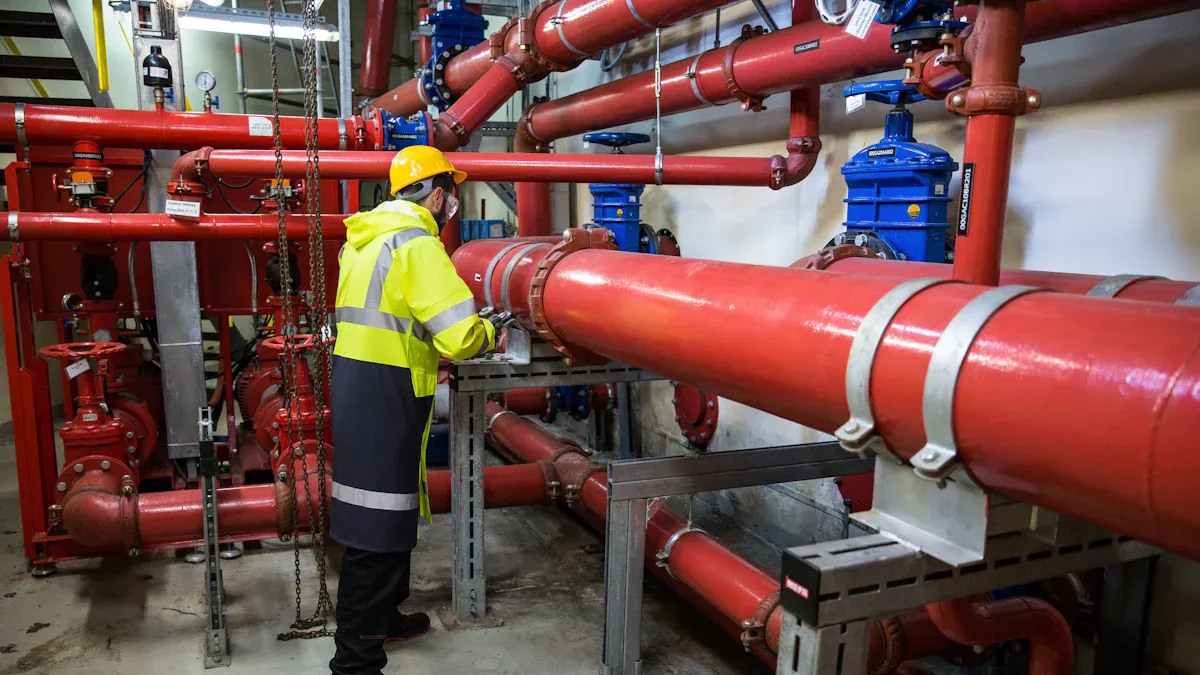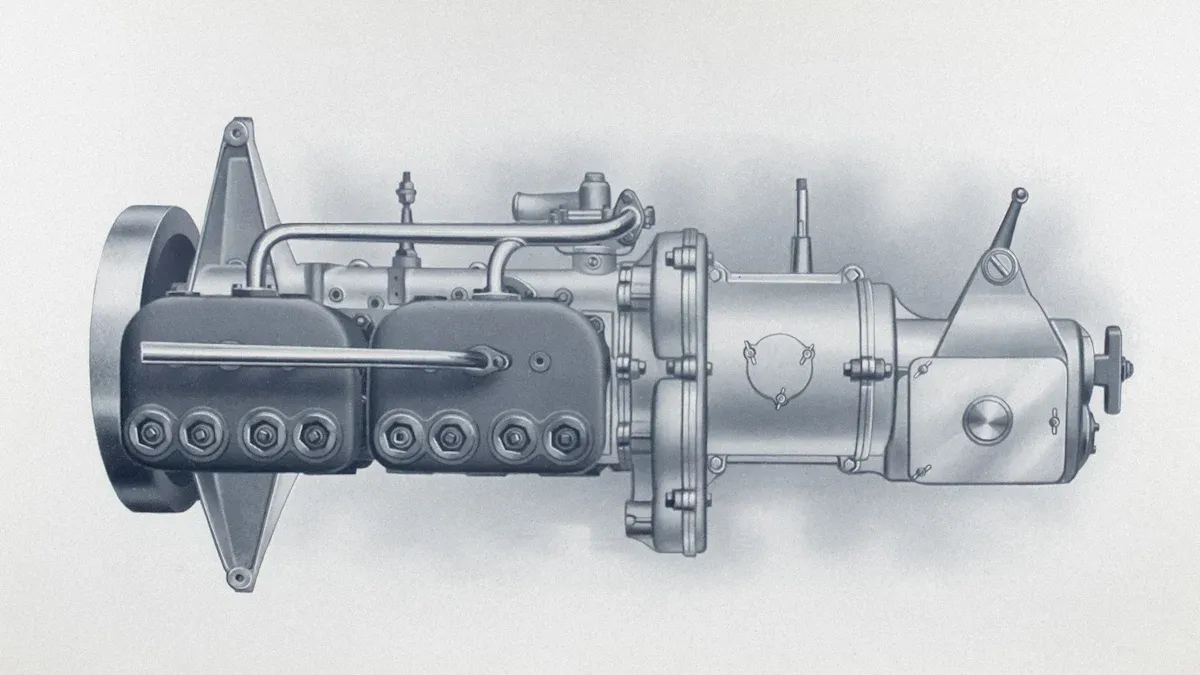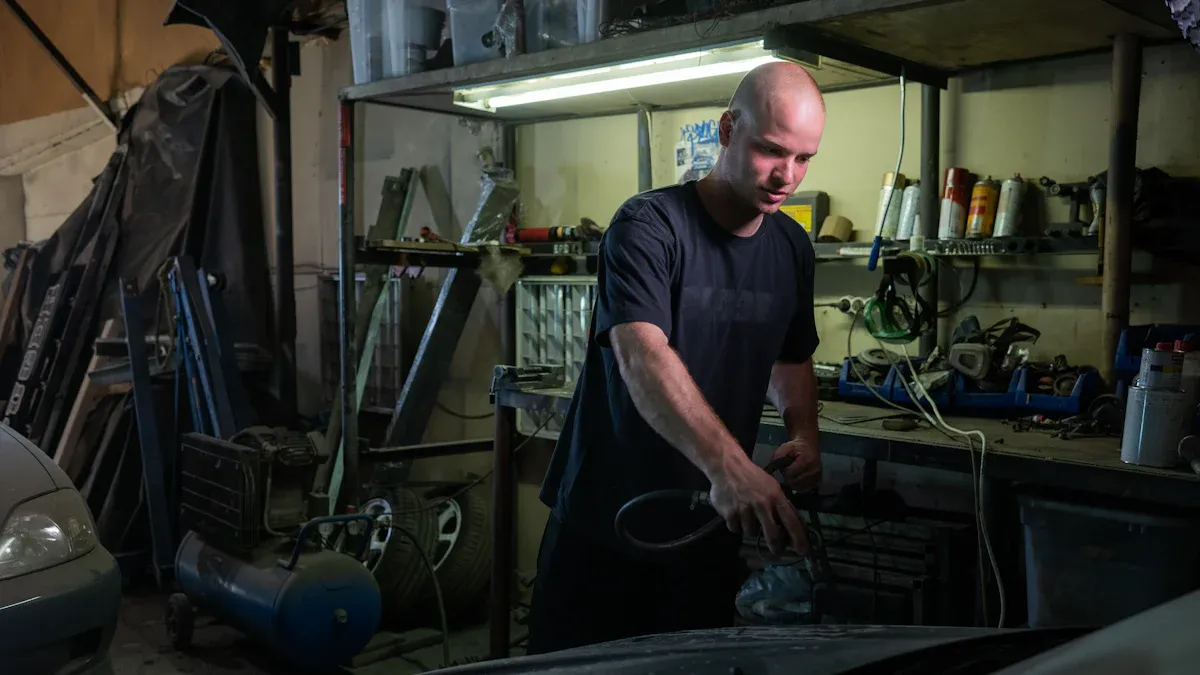
Hydraulic hose leaks often start at hydraulic fittings, as nearly 40% of failures begin there. High-pressure hose fittings that lack proper hose fitting sealing methods can cause oil leaks, leading to workplace injuries and costly downtime. Using the correct BSPT to NPT adapter helps reduce risks and ensures safer operations.
Key Takeaways
- Choose high-quality hydraulic hoses that meet industry standards to ensure safety and prevent leaks.
- Install hoses carefully by avoiding twists and sharp bends, using the right fittings, and following proper procedures.
- Inspect hoses regularly for damage and replace them on time to avoid costly breakdowns and safety risks.
Step 1: Choose Quality Hydraulic Hose

Why Quality Matters for Hydraulic Hose
A high-quality hydraulic hose keeps a system safe and reliable. Industry standards like SAE, ISO, and DIN set rules for pressure ratings, size, and safety. These hoses must handle high pressures, temperature changes, and tough environments. They go through tests for burst strength, flexibility in cold, and resistance to abrasion. Matching the hose, fittings, and seals is important because the weakest part sets the limit for the whole assembly. When a hydraulic hose meets these standards, it lasts longer and helps prevent leaks.
Tip: Always check if the hose meets the right standards for your industry.
How to Select the Right Hydraulic Hose
Choosing the right hydraulic hose means looking at several factors. Size and diameter must fit the system’s needs. The hose must handle the highest pressure and temperature it will face. The material should match the fluid inside and the environment outside. For example, metal hoses last the longest and prevent leaks best, but rubber hoses are more flexible and cost less. Thermoplastic hoses work well with chemicals but may not last in extreme heat or cold.
| Hose Material | Durability | Leak Prevention | Key Advantages | Key Limitations |
|---|---|---|---|---|
| Rubber | Moderate | Moderate | Flexible, affordable | Can degrade with chemicals or UV |
| Thermoplastic | Good | Moderate | Lightweight, chemical resistant | Less flexible in cold, can kink |
| Metal | Excellent | High | Very durable, handles harsh conditions | Heavy, less flexible, costly |
Mistakes to Avoid When Choosing Hydraulic Hose
Some common mistakes can lead to leaks and failures:
- Ignoring pressure ratings can cause hoses to burst.
- Picking the wrong size restricts flow and increases wear.
- Using hoses that do not match the fluid can cause swelling or cracking.
- Forgetting about temperature limits weakens the hose.
- Not checking for UV, chemicals, or abrasion can shorten hose life.
Selecting the right hydraulic hose and avoiding these mistakes helps keep equipment safe and leak-free.
Step 2: Hydraulic Hose Installation Best Practices
Proper Installation Techniques for Hydraulic Hose
Correct installation of a hydraulic hose helps prevent leaks and extends system life. Technicians should always select hoses that match the system’s pressure, temperature, and fluid requirements. Using the right length allows for movement without causing stress. Cleanliness is important. Hoses and fittings must be free from dirt before assembly. Workers should use proper tools and safety gear during installation. Following a checklist—inspection, cutting, fitting assembly, lubrication, tightening to torque specs, leak inspection, secure attachment, and system testing—ensures a reliable connection.
Tip: Store hoses away from sunlight and use caps or plugs when hoses are not in use to prevent contamination.
Preventing Twists, Sharp Bends, and Friction
Twisting or sharply bending a hydraulic hose during installation creates weak spots. These weak spots can lead to leaks or even bursts. Sharp bends that exceed the hose’s minimum bend radius damage the internal structure. Friction from rubbing against sharp edges or moving parts causes abrasion, which weakens the hose wall. To prevent these problems, technicians should:
- Avoid twisting hoses during installation.
- Use clamps and supports to keep hoses in place.
- Follow the manufacturer’s recommended bend radius.
- Add abrasion-resistant sleeves if hoses run near moving parts.
Proper routing and support help extend hose life and reduce leak risk.
Fittings and Connections for Leak Prevention
Choosing the right fittings and connections is key to leak prevention. O-ring face seal fittings provide a strong, leak-free seal, especially in high-pressure systems. Mated angle fittings, such as JIC 37-degree flare, create tight metal-to-metal seals. Tapered thread fittings are less reliable for high-pressure use. Technicians should avoid over-tightening or under-tightening fittings, as both can cause leaks. Regular inspection and replacement of seals help maintain a leak-free system. Consulting experts and following manufacturer guidelines ensures the best results.
Step 3: Hydraulic Hose Inspection and Maintenance

What to Check During Hydraulic Hose Inspections
A thorough inspection helps prevent leaks and failures. Technicians should follow these steps:
- Visually inspect all hoses and connections for oil leaks, wet spots, or pooling fluid.
- Check the entire hose length for abrasions, cracks, or bulges.
- Focus on fittings and couplings, as these are common leak sources.
- Use high-intensity flashlights and mirrors to see hard-to-reach areas.
- Perform pressure testing by isolating the hose section and monitoring for pressure drops.
- Interpret pressure test results: stable pressure means no leaks, while drops require further inspection.
Signs of Wear, Damage, or Leaks
Technicians can spot problems early by looking for these indicators:
- Cracks, frayed surfaces, or blisters on the hose
- Wetness or fluid leaks near connectors or fittings
- Pools of hydraulic fluid under equipment
- Abrasion or scuff marks from movement or poor routing
- Unusual noises like hissing or whining
- Loose or frequently loosening fittings
Tip: Early detection of these signs can prevent costly breakdowns and keep equipment safe.
Maintenance Tips and Inspection Schedules
Proper maintenance extends hose life and reduces risk. The table below shows recommended inspection frequencies:
| Usage Type | Inspection Frequency & Type |
|---|---|
| High-Demand / Severe | Daily visual checks, weekly physical inspections, monthly comprehensive checks, pre-shift in high-risk areas |
| Moderate Use | Weekly visual checks, bi-weekly physical inspections, monthly detailed checks |
| Light Use | Pre-use visual checks, monthly physical inspections, quarterly detailed checks |
| Special High-Risk | Daily inspections for emergency vehicles and extreme environments |
Technicians should route hoses properly, secure them with clamps, use protective sleeves, and keep hoses clean. Regular preventive maintenance and timely replacement help a hydraulic hose last up to five years.
Step 4: Timely Hydraulic Hose Replacement
When to Replace a Hydraulic Hose
A hydraulic hose should be replaced before it fails. Most manufacturers recommend changing hoses every 5 to 10 years, even if they look fine. The Society of Automotive Engineers (SAE) sets a shelf life of six years for unused rubber hoses. Actual service life depends on pressure, temperature, fluid type, and environment. Regular inspections help spot problems early. Hoses with hardening, cracks, bulges, or damaged fittings need immediate replacement. Keeping records of inspections and replacements helps track hose life and plan ahead.
Note: Replace hoses before heavy workloads or when signs of wear appear to avoid sudden breakdowns.
Dangers of Delaying Replacement
Delaying hydraulic hose replacement can cause serious problems. High-pressure leaks may lead to burns or fluid injection injuries. Hydraulic fluid spills can pollute soil and water, leading to expensive cleanup and fines. Equipment may stop working, causing project delays and lost time. Damaged hoses can harm pumps, motors, or cylinders, increasing repair costs. Poor maintenance can also hurt a company’s reputation.
- Safety hazards: burns, slips, and mechanical injuries
- Environmental risks: soil and water pollution
- Financial losses: repairs, downtime, and fines
Safe Replacement Procedures
Safe hose replacement protects workers and equipment. Always release system pressure before starting. Wear gloves, safety glasses, and protective clothing. Inspect hoses for cracks, bulges, or leaks before and after use. Use the correct hose type and size for the job. Avoid using hands to check for leaks; use cardboard or wood instead. Secure hoses with clamps and sleeves to prevent rubbing and whipping. Train workers on safe handling and emergency steps.
Tip: Regular training and detailed records help keep hydraulic systems safe and reliable.
Following these five steps greatly reduces hydraulic hose leaks:
- Cleaning and preparing hose ends prevents contamination.
- Using compatible fittings and correct routing stops damage.
- Regular inspections and maintenance double hose lifespan and cut downtime.
- Proactive care lowers costs, boosts safety, and keeps equipment running smoothly.
Making these steps routine helps avoid expensive repairs and unexpected breakdowns.
FAQ
How often should technicians inspect hydraulic hoses?
Technicians should inspect hoses at least once a month. High-use systems may need weekly or daily checks. Regular inspections help catch leaks and damage early.
What causes most hydraulic hose leaks?
Most leaks start at fittings or from worn hoses. Poor installation, wrong hose selection, and lack of maintenance also increase leak risk.
Can a small hydraulic leak cause serious problems?
Even a small leak can lead to equipment failure, safety hazards, and environmental damage. Quick repairs prevent bigger issues and keep systems running safely.
Post time: Aug-07-2025
